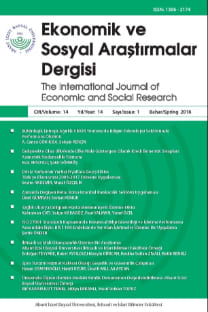HANEHALKI TÜKETİM HARCAMALARI İLE KİŞİBAŞINA DÜŞEN MİLLİ GELİR ARASINDAKİ NEDENSELLİK İLİŞKİSİ: TÜRKİYE ÖRNEĞİ
Bu çalışmada, hanehalkı tüketim harcamaları ile kişibaşına düşen milli gelir arasındaki nedensellik ilişkisi, Türkiye için alternatif yöntemlerle incelenmiştir. Bu amaçla iki değişken arasındaki ilişki Türkiye için 1987-2018 döneminde, ARDL sınır testi ve TY-VAR nedensellik testi ile analiz edilmiştir. ARDL sınır testinin sonuçları, değişkenler arasında uzun dönemde pozitif bir ilişkinin olduğunu gösterirken, TY-VAR nedensellik testi hanehalkı tüketim harcamalarından kişibaşına düşen milli gelire doğru tek yönlü nedenselliğin olduğunu göstermektedir.
Anahtar Kelimeler:
Tüketim Harcamaları
___
- Akekere, J. & Yousuo, P.O.L. (2012). Empirical analysis of change in ıncome on private consumption expenditure in Nigeria from 1981 to 2010. International Journal of Academic Research in Business and Social Sciences, 2(11), 321-331.
- Alimi, S.R. (2013). Keynes’ absolute ıncome hypothesis and Kuznets paradox. Erişim Tarihi: 17.10.2016, https://mpra.ub.uni-muenchen.de/49310/1/MPRA_paper_49310.pdf
- Altınöz, U. (2014). Tüketim fonksiyonu ve Türkiye için gelir-tüketim ilişkisinin ampirik analizi. International Conference on Eurasian Economies, 1-7.
- Amin, S.B. (2011). Causal relationship between consumption expenditure and economic growth in Bangladesh. World Journal of Social Sciences, 1(2), 158-169.
- Apere, T.O. (2014). Private consumption expenditure function in Nigeria: Evidence from the Keynes’ absolute income hypothesis. International Journal of Research in Social Sciences, 4(3), 53-58.
- Campbell J.Y & Mankiw, G.N. (1991). The response of consumption to ıncome: A Cross-Country investigation. European Economic Review, 35, 723-767.
- Cerrat, M., Peretti, C. & Stewart, C. (2008). Is the consumption-ıncome ratio stationary? Evidence from linear and nonlinear panel unit root tests for OECD and Non-OECD countries. Scottish Institute for Research in Economics, 1-27.
- Chioma, N.J. (2009). Causal relationship between gross domestic product and personal consumption expenditure of Nigeria. African Journal of Mathematics and Computer Science Research, 2(8), 179-183.
- Dickey, D.A. & Fuller, W.A. (1981). Likelihood ratio statistics for autoregressive time series with a unit root. Econometrica, 49(4), 1057-1072.
- Do M.K. & Zhang R. (2014). The Granger causality relationship between household consumption and GDP of Vietnam and China. Eastern Academic Forum, 315-322.
- Duesenberry, J.S. (1949). Income, saving and theory of consumer behavior. Harvard University Press, Cambridge.
- Friedman, M. (1957). A theory of consumption function. National Bureau of Economic Research, New York.
- Guisan, C.M. (2001). Causality and cointegration between consumption and GDP in 25 OECD countries: Limitations of the cointegration approach. Applied Econometrics and International Development, 1(1), 39-61.
- Guisan, C.M. (2004). A comparison of causality tests applied to the bilateral relationship between consumption and GDP in the USA and Mexico. International Journal of Applied Econometrics and Quantitative Studies, 1(1), 115-130.
- Güreşçi-Pehlivan, G. & Utkulu, U. (2007). Türkiye’nin tüketim fonksiyonu: Parçalı hata düzeltme modeli bulguları. Akdeniz İktisadi ve İdari Bilimler Dergisi, 14, 39-65.
- Keynes J.M. (1936). The general theory of employment, ınterest and money. London Press.
- Mankiw, G.N. (2010). Makroekonomi. (Çev. Ömer Faruk Çoklak). Efil Yayınevi, Ankara.
- Mishra, P.K. (2011). Dynamics of the relationship between real consumption expenditure and economic growth in India. Indian Journal of Economics & Business, 10(4), 553-563.
- Modigliani, F. & Ando, A. (1963). The life cycle hypothesis of saving: Aggregated implications and test. American Economic Review, 53, 55-84.
- Narayan, P.K. (2005). The saving and ınvestment nexus for China: Evidence from cointegration tests. Applied Economics, 37(17), 1979-1990.
- Narayan, P.K. & Smyth, R. (2008). Energy consumption and real GDP in G7 countries: New evidence from panel cointegration with structural breaks. Energy Economics, 30, 2331-2341.
- Ofwona, A.C. (2013). An estimation of the consumption function for Kenya using Keynes’ absolute income hypothesis for the period 1992-2011. Journal of Emerging Trends in Economics and Management Sciences, 4(1), 103-105
- Pesaran, M.H., Shin, Y. & Smıth, R.J. (2001). Bounds testing approaches to the analysis of level relationships. Journal of Applied Econometrics, 16(3), 289-326.
- Phillips, P.C.B. & Perron, P. (1988). Testing for a unit root in time series regression. Biometrika, 75(2), 335-346.
- Tapsın, G. & Hepsag, A. (2014). An analysis of in EA-18. European Scientific Journal, 10(16), 1857-7881.
- Toda, H.Y. & Yamamoto, T. (1995). Statistical inference in vector autoregressions with possibly ıntegrated processes. Journal of Econometrics, 66(1), 225-250.
- Yılancı, V., Zeren, F. & Arı, A. (2013). Tüketim-Gelir oranı Güneydoğu Asya ülkelerinde durağan mı?: Panel birim kök testi. Yönetim ve Ekonomi Araştırmaları Dergisi, 21, 130-139.
- ISSN: 1306-2174
- Yayın Aralığı: Yılda 2 Sayı
- Başlangıç: 2005
- Yayıncı: Abant İzzet Baysal Üniversitesi İktisadi ve İdari Bilimler Fakültesi
Sayıdaki Diğer Makaleler
MEVDUAT VE KATILIM BANKALARININ KREDİ TEKLİF VE TAHSİS SÜREÇLERİ AÇISINDAN KARŞILAŞTIRILMASI
EŞDEĞERLİK ÖLÇEĞİ SEÇİMİNE GÖRE YOKSULLUK GÖSTERGELERİNİN ANALİZİ: TÜRKİYE UYGULAMASI
DOĞRUDAN YABANCI YATIRIMLAR VE İŞSİZLİK: BRICS ÜLKELERİ İÇİN BİR NEDENSELLİK ANALİZİ
DEMOKRAT PARTİ DÖNEMİ AFYON ÜRETİM VE TİCARETİ
İNOVASYONUN YENİ YÜZÜ: AÇIK YEŞİL İNOVASYON
Ahmet ŞİT, Haydar KARADAĞ, Mustafa ŞİT
AVRASYA JEOPOLİTİĞİNDE TÜRKİYE'NİN ENERJİ POLİTİKALARI: TANAP VE TÜRK AKIMI
AVRASYA JEOPOLİTİĞİNDE TÜRKİYE'NİN ENERJİ POLİTİKALARI: TANAP VE TÜRK AKIMI
